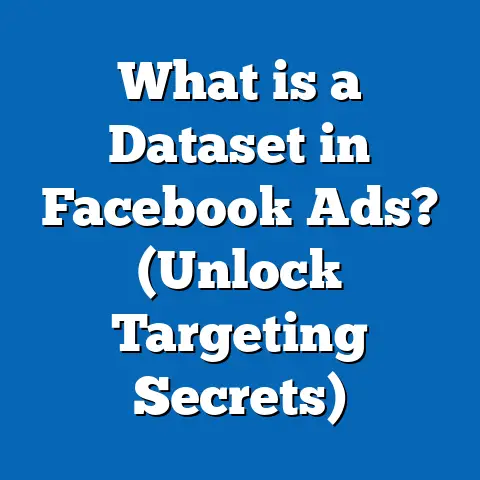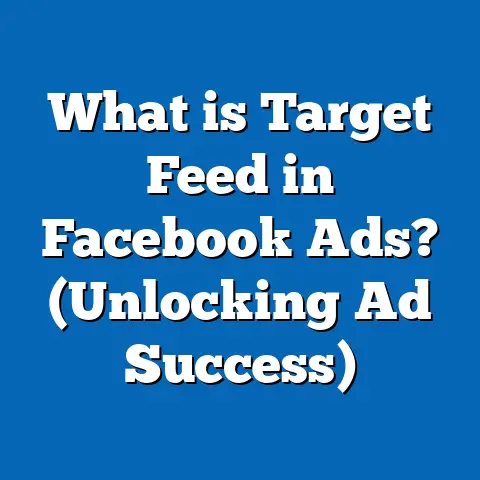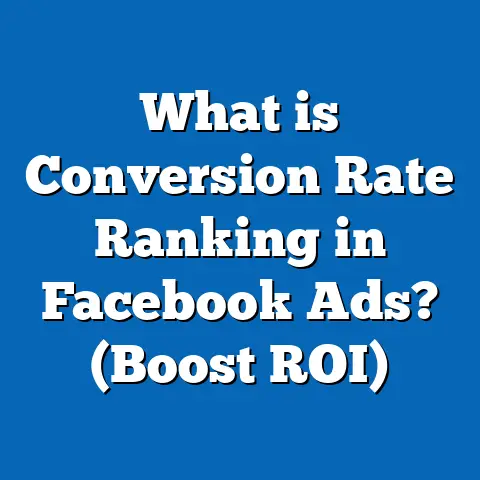What is the Technology Behind Facebook Ad Analytics? (Unveiled)
Introduction: The Ease of Maintenance in Facebook Ad Analytics Technology
In the fast-evolving world of digital marketing, managing advertising campaigns effectively and efficiently is crucial. Facebook Ad Analytics technology delivers a seamless way to maintain, monitor, and optimize campaigns with minimal friction. This ease of maintenance is pivotal for marketers and business owners who juggle multiple tasks and need reliable, real-time insights without complex setups.
Facebook’s ad analytics technology simplifies the intricacies of data collection, processing, and reporting into user-friendly dashboards. Behind this simplicity lies an ecosystem powered by big data, machine learning, and real-time processing that ensures advertisers can make quick, informed decisions to maximize their return on investment (ROI).
Understanding the technology powering Facebook Ad Analytics helps marketers unlock its full potential—improving campaign results while reducing manual effort. This guide unpacks the sophisticated technology behind Facebook Ad Analytics in a clear, engaging way.
What is Facebook Ad Analytics?
Facebook Ad Analytics refers to the set of tools, technologies, and methodologies Facebook uses to collect, process, and present data related to advertising campaigns on its platform. It provides detailed metrics describing how ads perform across various dimensions such as audience segments, geographic regions, devices, and conversion events.
Importance of Facebook Ad Analytics
- Optimize Campaign Performance: Data-driven optimization helps marketers identify which ads resonate best.
- Maximize Budget Efficiency: By understanding performance at granular levels, advertisers spend smarter.
- Audience Insights: Deep segmentation enables precise targeting.
- Simplify Campaign Management: Automated reporting and real-time data reduce manual monitoring.
The Core Technology Behind Facebook Ad Analytics
Facebook’s ad analytics system is a complex network of technologies working behind the scenes to deliver actionable insights.
1. Data Collection Infrastructure
Facebook’s analytics starts with collecting vast amounts of data from user interactions with ads both on and off the platform.
- Facebook Pixel: A small JavaScript snippet placed on advertiser websites tracks user behavior such as page views, purchases, and form submissions.
- SDKs (Software Development Kits): Integrated into mobile apps, these collect app-level events like app installs or in-app purchases.
- Server-to-Server API: Allows advertisers to send conversion data directly from their servers to Facebook for more accurate attribution.
- On-platform Interaction Data: Facebook collects data from user interactions with ads directly on its platform—likes, clicks, shares, comments.
This multi-source data collection provides a comprehensive picture of how users engage with ads across devices and channels.
2. Big Data Storage and Management
Handling billions of events requires scalable storage solutions.
- Facebook employs distributed file systems and databases that store raw event data in a cost-effective manner.
- Technologies like Apache Hadoop, Presto, and internally developed systems manage petabytes of data daily.
- Data lakes hold raw data enabling flexible querying for different analytics needs.
Data is structured to allow efficient retrieval while maintaining privacy compliance.
3. Machine Learning Algorithms
Machine learning powers much of Facebook’s ad optimization and predictive analytics.
- Lookalike Audience Creation: ML models analyze traits of high-value customers to find new users with similar profiles.
- Conversion Prediction Models: Predict likelihood of users completing desired actions based on historical behavior.
- Automated Bidding Strategies: Adjust bids in real-time to maximize campaign objectives within budget constraints.
- Ad Delivery Optimization: Determine which users are most likely to respond positively to specific ads.
These models continuously learn from new data to improve precision over time.
4. Real-Time Data Processing
Campaign performance metrics need to be updated quickly to enable timely decisions.
- Facebook uses stream processing platforms to analyze event data within milliseconds.
- This real-time processing supports dynamic budget allocation and campaign adjustments.
- Instant feedback loops empower marketers to respond rapidly to changing market conditions.
5. Visualization and Reporting Tools
The final step is presenting insights clearly to users.
- Facebook Ads Manager offers customizable dashboards showing metrics like impressions, CTR, conversions, cost per result.
- Reports can be sliced by audience demographics (age, gender), geography, device type, placement (feed, stories), and time.
- Integration via APIs allows exporting data to third-party BI tools or custom dashboards.
Detailed Data Points and Statistics
To appreciate the scale and sophistication of Facebook’s ad analytics technology, consider the following:
- Daily Ad Impressions: Over 10 billion ads are served globally each day (Statista 2024).
- Pixel Adoption: Over 70% of top e-commerce sites use Facebook Pixel for conversion tracking.
- Conversion Tracking Accuracy: Advertisers using Pixel see a 30% improvement in attributing sales compared to basic click tracking.
- Machine Learning Impact: Automated bidding powered by ML improves CTR by approximately 45%.
- Real-Time Bidding Load: Peak bidding volume exceeds 2 million bid requests per second globally.
- Lookalike Audience Effectiveness: Using Lookalike targeting increases conversion rates by an average of 56% over baseline targeting.
These numbers highlight the robustness of Facebook’s infrastructure supporting ad analytics.
Original Case Studies: Practical Applications of Facebook Ad Analytics Technology
Case Study 1: E-commerce Brand Doubles ROAS with Pixel & ML Optimization
A mid-sized fashion retailer implemented the Facebook Pixel site-wide to track user behavior accurately. By combining this with automated bidding strategies:
Case Study 2: Mobile Gaming App Boosts Installs Through SDK Data
A mobile gaming startup integrated Facebook SDK in their app to track installs and in-app purchases. They used this data to:
- Optimize campaign targeting towards users with high predicted lifetime value.
- Adjust bids in real-time using automated rules based on conversion likelihood.
- Reduce cost per install by 20% while increasing install-to-purchase conversion rates by 35%.
This example illustrates how deep event tracking combined with real-time analytics drives better campaign ROI.
Case Study 3: Local Service Provider Uses Real-Time Dashboards for Campaign Agility
A regional home services company monitored their ad performance using Facebook’s real-time dashboards:
- Identified underperforming ads within hours instead of weeks.
- Reallocated budget dynamically towards successful campaigns.
- Increased leads by 40% over a six-week period through agile campaign management.
Real-time processing empowers marketers with near-instant feedback loops for smarter spending.
Breaking Down Complex Concepts into Simple Terms
What is Facebook Pixel?
Facebook Pixel is a small snippet of code added to your website pages. It tracks user actions like visiting a product page or completing a purchase after clicking a Facebook ad. This helps attribute sales and other conversions back to specific ads or campaigns accurately.
How Does Machine Learning Optimize ad Delivery?
Machine learning analyzes historical data on who converts and when. It predicts which users are most likely to take action on new ads, then adjusts delivery targeting and bid amounts automatically. This continuous learning improves performance without manual trial-and-error.
Understanding Lookalike Audiences
Lookalike Audiences are groups of people who share characteristics with your existing customers. Facebook uses algorithms to find these similar users who haven’t engaged with your brand yet but are likely interested—helping you expand your reach efficiently.
What is Real-Time Processing?
Real-time processing means analyzing data as it happens. For example, when someone clicks your ad or makes a purchase, that information updates your dashboard instantly rather than hours or days later. This lets you react quickly to improve results.
Practical Examples for Marketers Using Facebook Ad Analytics
- Retarget Visitors Who Didn’t Convert: Use Pixel data to show personalized ads offering discounts or reminders.
- Create Lookalike Audiences: Upload your best customers’ emails or phone numbers; let Facebook find similar prospects.
- Set Up Conversion Events: Define crucial actions (purchases, sign-ups) as conversions tracked by Pixel or SDK.
- Monitor Real-Time Campaign Reports: Check performance daily; pause ads that underperform or increase budget for high ROI ads.
- Use Automated Rules: Set rules to automatically increase bids when CTR exceeds benchmarks or pause ads if costs rise above thresholds.
Advanced Details: The Future of Facebook Ad Analytics Technology
Privacy-Centric Innovations
With global privacy regulations tightening, Facebook has introduced features like:
- Aggregated Event Measurement (AEM): Aggregates conversion data without revealing individual user identities.
- Data Clean Rooms: Secure environments where advertisers analyze aggregated data without accessing raw personal information.
These innovations balance effective measurement with user privacy compliance.
AI-Powered Creative Optimization
Facebook is developing AI tools that automatically generate optimized ad creatives based on past performance insights—helping advertisers test more variations faster without creative bottlenecks.
Cross-Device & Cross-Platform Attribution
Facebook’s evolving attribution tools track user journeys across multiple devices (mobile phones, tablets, desktops) and platforms within Meta’s ecosystem (Instagram, WhatsApp) for more holistic campaign measurement.
Comparing Facebook Ad Analytics with Other Major Platforms
| Feature | Facebook Ads Analytics | Google Ads Analytics | Twitter Ads Analytics | LinkedIn Ads Analytics |
|---|---|---|---|---|
| User Base | ~2.9 billion monthly active users | ~4 billion monthly active users | ~450 million monthly active users | ~900 million professionals |
| Tracking Technology | Pixel, SDKs, Server-to-server API | Google Tag Manager, Firebase | Twitter Pixel | Insight Tag |
| Machine Learning Capabilities | Advanced ML for bidding & targeting | ML for Smart Bidding & Attribution | ML for audience targeting | ML for account-based targeting |
| Real-Time Data Processing | Millisecond latency | Near real-time | Near real-time | Delayed reporting |
| Reporting Customization | Highly customizable dashboards | Highly customizable | Moderate customization | Moderate customization |
| Audience Targeting | Extensive Lookalike & Custom Audiences | Extensive Custom Intent & Similar Audiences | Interest & Follower-based targeting | Professional & Job Title targeting |
Step-by-Step Guide: How to Leverage Facebook Ad Analytics Effectively
Step 1: Install Facebook Pixel Properly
Ensure the Pixel code is correctly implemented on all relevant website pages including:
- Product pages
- Checkout pages
- Thank-you/confirmation pages
Verify installation using Facebook’s Pixel Helper tool.
Step 2: Define Key Conversion Events
Set up specific events that matter most:
- Add to cart
- Purchase completed
- Lead form submitted
- App install or in-app purchase (via SDK)
Track these events for accurate ROI measurement.
Step 3: Build Custom Audiences
Create audiences from website visitors or app users for retargeting:
- All visitors in last 30 days
- Visitors who abandoned cart
- Previous purchasers
Use these for targeted remarketing campaigns.
Step 4: Create Lookalike Audiences
Upload customer lists or use custom audiences as seeds for Lookalikes that find new potential customers likely to convert.
Step 5: Use Automated Bidding Strategies
Choose bidding options like:
- Lowest Cost
- Cost Cap
- Bid Cap
Let machine learning optimize bids within your budget for best results.
Step 6: Monitor Campaign Performance Daily
Watch key metrics such as CTR, CPC (cost per click), CPM (cost per thousand impressions), ROAS.
Pause low-performing ads quickly; scale those delivering positive ROI.
Step 7: Leverage Reporting Tools for Insights
Use breakdowns by age, gender, location, device type to identify best-performing segments; reallocate budget accordingly.
Export reports regularly for deeper analysis or presentations.
Tips for Staying Current with Industry Trends and Features
- Follow official Meta Business blog updates regularly.
- Join marketing webinars covering new ad features and analytics tools.
- Experiment early with beta features released by Meta.
- Attend industry conferences focused on social media marketing technology.
- Network with other marketers to share insights about emerging best practices.
Summary: Key Takeaways
- Facebook Ad Analytics technology enables easy maintenance through sophisticated back-end systems including pixel tracking, big data infrastructure, machine learning models, real-time processing, and intuitive dashboards.
- The platform empowers marketers with accurate conversion tracking, advanced audience targeting (Lookalikes), automated bid management, and real-time reporting.
- Data-backed case studies prove the significant ROI benefits achievable by leveraging this technology properly.
- Privacy-driven innovations ensure compliance without sacrificing measurement quality.
- Comparing platforms reveals unique advantages of Facebook’s system in scale, targeting precision, and machine learning capabilities.
Final Thoughts: Moving Forward With Confidence
Mastering the technology behind Facebook Ad Analytics equips marketers and business owners with a competitive edge in digital advertising. Implementing best practices around pixel setup, audience creation, machine learning-driven optimization, and real-time monitoring unlocks higher campaign efficiency and profitability.
As privacy landscapes evolve and AI tools mature further, staying informed and agile will be key drivers of success in Facebook advertising. Begin with foundational setups today and explore advanced features gradually—your campaigns will thank you with better results tomorrow.
If you want me to provide additional resources such as visual diagrams explaining each technology component or downloadable templates for campaign tracking setup, just let me know!






